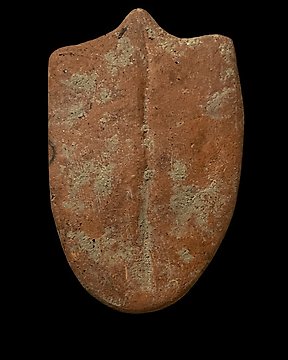
Etrusco Terracotta Lingua votiva con licenza di esportazione spagnola - 0.6×5.4×8.4 cm
N. 70451865

N. 70451865

Dignatary
- fine quality -
- Thermoluminescence test attached -
CULTURE: Jaina Island, Maya, Mexico
PERIOD: 500 - 700 AD
MATERIAL: Terracotta.
SIZE: Height 19 cm.
PROVENANCE: Jules Breman old collection, California, USA. Created in the 1970s.
CONDITION: Good condition, intact.
DESCRIPTION:
Jaina Island is a pre-Columbian Maya archaeological site in the present-day Mexican state of Campeche. A small limestone island on the Yucatán Peninsula's Gulf coast with only a tidal inlet separating it from the mainland, Jaina served as an elite Maya burial site, and is notable for the high number of fine ceramic figurines excavated there.
Jaina Island's notability is tied to its estimated 20,000 graves, of which over 1,000 have been archaeologically excavated. Within each grave, the human remains are accompanied by glassware, slateware, or pottery as well as one or more ceramic figurines, usually resting on the occupant's chest or held in their hands.
Early Jaina-style figures are naturalistic, delicately detailed, and "generally regarded as the finest figurine art produced throughout the ancient Americas". While both solid and hollow figurines have been found, the latter predominate and are usually fitted with a whistle, or with clay pellets that produce a rattle-like sound. Like the figurines themselves, it is not known what function the whistles and rattles served. Made of orange clay and originally painted, mostly in ochres and blues, the figurines are generally small.
These figures also represent Mayan practices of scarification and the significance of class in Mayan society. Details such as marks on the figure's face as well as clothing and jewelry can be used to signify social status of the figure.
All the figurines on Jaina Island seem to have been produced specifically as burial accompaniments. Due, if nothing else, to space considerations, few if any of these figurines could have been produced on the island itself. Many of the molded figurines have been linked to workshops at Jonuta, some distance to the south and west.
Created in a realistic style, the figurines are an ethnographic treasure trove, affording a glimpse into the physical features, dress, and daily life of the late Classic Maya elite. Their delicate detail reveals hallmarks of social status and the figurines are often shown with tools and other accoutrements, providing us three-dimensional snapshots of long-vanished implements.
Notes:
The seller guarantees that he acquired this piece according to all national and international laws related to the ownership of cultural property. Provenance statement seen by Catawiki.
The seller will take care that any necessary permits, like an export license will be arranged, he will inform the buyer about the status of it if this takes more than a few days.
The piece includes authenticity certificate.
The piece includes Spanish Export License.
Come fare acquisti su Catawiki
1. Scopri oggetti speciali
2. Fai l’offerta più alta
3. Paga in tutta sicurezza